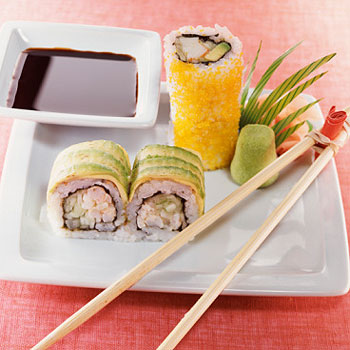
Sushi has become a popular trend in many
The art of sushi takes years of training, especially to truly master a great roll or some of the more complicated combinations. But anyone can make their sushi bar favorites in the comfort of their own kitchen.
Obtaining Your Sushi Ingredients
With the international sections of our grocery stores ever-expanding, you should be able to find most of the key ingredients for your sushi experience right on the shelves. The main things you need for any basic sushi roll are:
- Sushi rice - smaller, fatter grained white rice
- Sheets of nori - roasted, dry seaweed
- Sushi vinegar - can be found in some stores, or made by mixing 5 tablespoons rice wine vinegar with 2 teaspoons of sugar and a 1/2 teaspoon of salt
- Plastic wrap
Vegetables like cucumber, avocado, scallion, and carrot are all commonly found in sushi rolls (and grocery stores). Some rolls even use fruits like mango, kiwi and strawberry to create bold flavor combinations.
Your local seafood counter should be able to suggest the best fish to use, as not all fish are suitable for raw consumption. You'll need to make sure any fish you purchase is "sushi grade." Your local grocery store or fish market can also remove the bones and skin for you. Salmon and tuna that are brightly colored and firm are excellent choices. Shrimp should never be eaten raw, but can be used when cooked and peeled, or you could purchase imitation crab sticks which are also pre-cooked and ready to roll.
If working with raw fish, make sure that you keep it refrigerated at all times. If it has a strong fishy odor, or is dull in color (salmon should be bright orange; tuna, a medium pink to dark red), it's probably best not to use it.
Preparing Your Sushi Rice
Making good sushi rice takes time, practice and some patience. To start, you should have the proper type of rice. Not just any rice will do, you need to purchase a brand that specifically states that it is for use in making sushi. Sushi rice is a shorter, fatter grain of rice that has the right balance of starches to allow it to stick together.
When cooking your rice, it's best to follow the instructions on the package. Most brands will say equal parts rice and water, some may say 1/4 cup more water. The rice should be rinsed first so the water runs clear before adding the necessary water for cooking.
As the rice cooks, prepare the bowl and seasoning for the final product. A stainless steel bowl works best, and you'll need the sushi vinegar on hand as well. The sushi vinegar recipe in part A will make enough seasoning for approximately 4 cups of cooked rice.
Sprinkle the sushi vinegar on the rice and then using a spatula or bamboo scoop, use a cutting and folding motion to mix and cool the rice. Be careful not to smash the rice into a paste. You want to allow the rice to cool to room temperature, so fanning during this process is also a good idea.
Proper Slicing of Your Sushi Fillings
Thin, long strips are best for preparing sushi rolls, as they're easy to slice and bite through. Sharp knives are critical to having good, clean cuts and thin slices. You should try for as thin and manageable of chunks as you can slice, as they'll be easier to eat in the finished product.
For sashimi, slice your fish with the grain so the cuts aren't tough or chewy. Also keep in mind that if you are making nigiri, the rice balls are normally only an inch or two in length, so your fish slices shouldn't be much bigger.
The 3
Sashimi is basically just sliced fish served raw. There's not much to do in the way of preparation except slicing your fish properly and making sure it's kept chilled until ready to serve. Pieces should be no more than 1/2 inch thick and about 2 inches in length.
Nigiri are balls of rice with a slice of fish, omelet, or shellfish on top. The rice ball should be formed to be about an inch thick and 2 inches long. Traditionally, a small bit of wasabi paste is placed on the ball before adding the topping, but you can omit it if you're not a fan of spicy flavors.
The basic sushi roll starts with placing a piece of plastic wrap on your table and laying down a sheet of nori. Using your flat spoon, spread a layer of sushi rice on the nori about 1/4 inch thick and covering the sheet almost to the edge, leaving about 1/2 inch of nori visible at the other end.
Place your toppings lengthwise on one end of the sheet about 1/2 inch away from the long edge. Try to stay simple as the more ingredients you add, the harder it is to roll up at the end. A common combination for a
Chopsticks can be found in many kitchen stores but traditionally chopsticks are only used to take individual pieces of sushi off the community plate to bring to your personal plate. At that point, many sushi fans prefer to use their fingers. If you have difficulty finding any of the ingredients, there are many specialty stores online that sell all sorts of sushi products. You can get creative with arranging your sushi on a platter, or invite everyone in the kitchen for a sushi-making party! Itadakimasu (let's eat)!